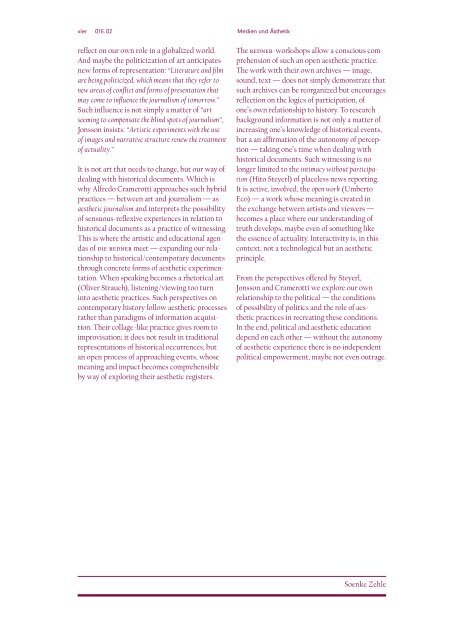KUNST DER DEMOKRATIE - Die Redner
KUNST DER DEMOKRATIE - Die Redner
KUNST DER DEMOKRATIE - Die Redner
Sie wollen auch ein ePaper? Erhöhen Sie die Reichweite Ihrer Titel.
YUMPU macht aus Druck-PDFs automatisch weboptimierte ePaper, die Google liebt.
vier 01E. 02 Medien und Ästhetik<br />
reflect on our own role in a globalized world.<br />
And maybe the politicization of art anticipates<br />
new forms of representation: “Literature and film<br />
are being politicized, which means that they refer to<br />
new areas of conflict and forms of presentation that<br />
may come to influence the journalism of tomorrow.”<br />
Such influence is not simply a matter of “art<br />
seem ing to compensate the blind spots of journalism”,<br />
Jonsson insists: “Artistic experiments with the use<br />
of images and narrative structure renew the treatment<br />
of actuality.”<br />
It is not art that needs to change, but our way of<br />
dealing with historical documents. Which is<br />
why Alfredo Cramerotti approaches such hybrid<br />
practices — between art and journalism — as<br />
aesthetic journalism and interprets the possibility<br />
of sensuous-reflexive experiences in relation to<br />
historical documents as a practice of witnessing.<br />
This is where the artistic and educational agendas<br />
of die redner meet — expanding our relationship<br />
to historical/contemporary documents<br />
through concrete forms of aesthetic experimentation.<br />
When speaking becomes a rhetorical art<br />
(Oliver Strauch), listening /viewing too turn<br />
into aesthetic practices. Such perspectives on<br />
contemporary history follow aesthetic processes<br />
rather than paradigms of information acquisition.<br />
Their collage-like practice gives room to<br />
improvisation; it does not result in traditional<br />
representations of historical occurrences, but<br />
an open process of approaching events, whose<br />
meaning and impact becomes comprehensible<br />
by way of exploring their aes thetic registers.<br />
The redner-workshops allow a conscious comprehension<br />
of such an open aesthetic practice.<br />
The work with their own archives — image,<br />
sound, text — does not simply demonstrate that<br />
such archives can be reorganized but encourages<br />
reflection on the logics of participation, of<br />
one’s own relationship to history. To research<br />
background information is not only a matter of<br />
in creasing one’s knowledge of historical events,<br />
but a an affirmation of the autonomy of perception<br />
— taking one’s time when dealing with<br />
historical documents. Such witnessing is no<br />
longer limited to the intimacy without participation<br />
(Hito Steyerl) of placeless news reporting.<br />
It is active, involved, the open work (Umberto<br />
Eco) — a work whose meaning is created in<br />
the exchange between artists and viewers —<br />
becomes a place where our understanding of<br />
truth develops, maybe even of something like<br />
the essence of actuality. Interactivity is, in this<br />
context, not a technological but an aesthetic<br />
principle.<br />
From the perspectives offered by Steyerl,<br />
Jonsson and Cramerotti we explore our own<br />
relationship to the political — the conditions<br />
of possibility of politics and the role of aes-<br />
thetic practices in recreating these conditions.<br />
In the end, political and aesthetic education<br />
depend on each other — without the autonomy<br />
of aes thetic experience there is no independent<br />
political empowerment, maybe not even outrage.<br />
Soenke Zehle


